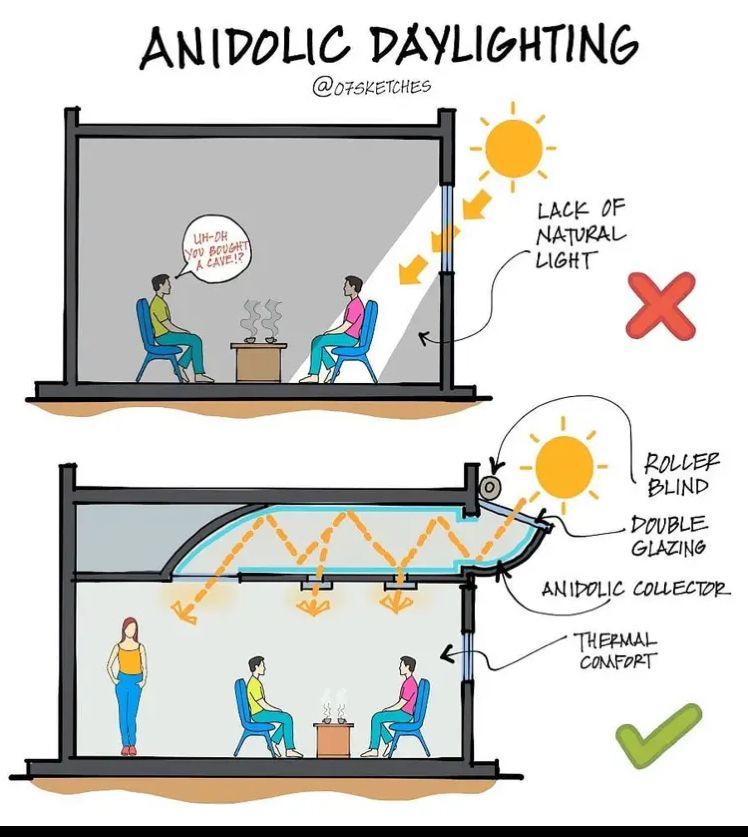From dark, cave-like rooms to sunlit, comfortable spaces — this innovation is reshaping architecture, sustainability, and human well-being.
🌞 The Problem: Living in the Dark
In today’s urban world, millions of people live in apartments, offices, and homes where natural light is scarce. Tall neighboring buildings, small windows, and poor design often leave rooms feeling dim and gloomy.
The top half of the illustration perfectly captures this problem: two people sit in a shadowy room with limited daylight. One even jokes, “Uh-oh, you bought a cave!?” — highlighting how lack of sunlight makes interiors depressing and uncomfortable.
Relying on artificial lights during the day is not only costly but also harmful to human well-being. Studies show that inadequate daylight exposure disrupts sleep cycles, reduces productivity, and even impacts mental health.
So, the question arises: How do we bring the sun indoors without compromising comfort?
💡 The Solution: Anidolic Daylighting
The bottom half of the image reveals the answer — Anidolic Daylighting Systems (ADS). This innovative technology captures, redirects, and spreads natural sunlight into interiors that would otherwise remain dark.
Here’s how it works:
- An anidolic collector captures sunlight from outside.
- Light passes through double glazing, ensuring energy efficiency.
- It’s reflected and distributed evenly across the room.
- Roller blinds provide shade control when needed.
- Occupants enjoy thermal comfort with bright, well-balanced daylight.
The result? A space that feels alive, warm, and inviting — all without excessive reliance on artificial lights.
🏗️ How It Works Step by Step
- Collection – The anidolic collector, often curved, gathers sunlight.
- Guidance – Sunlight is redirected deeper into the building.
- Diffusion – Reflectors scatter light evenly, avoiding glare.
- Control – Roller blinds let users fine-tune brightness levels.
- Comfort – Double glazing prevents overheating and maintains a stable indoor climate.
This ensures maximum daylight with minimum energy waste.
🌱 Environmental Benefits
Anidolic Daylighting is not just about brightness — it’s about sustainability.
- Reduced energy consumption – Less need for artificial lighting during the day.
- Lower electricity bills – Families and businesses save money.
- Smaller carbon footprint – Every kilowatt saved reduces greenhouse gas emissions.
- Passive heating – In colder climates, sunlight adds warmth naturally.
By adopting this system, cities can significantly cut energy demand while making homes and workplaces healthier.
🏡 Human-Centered Benefits
Natural daylight plays a vital role in human life. With Anidolic systems, occupants experience:
✨ Improved Mood – Sunlight boosts serotonin, helping fight stress and depression.
✨ Better Sleep – Daylight exposure regulates circadian rhythms.
✨ Enhanced Productivity – Offices and classrooms with daylight report higher performance.
✨ Visual Comfort – Balanced, glare-free light reduces eye strain.
The difference is clear in the illustration: the top room feels like a cave, while the bottom room feels alive and welcoming.
🌍 Applications in Modern Architecture
Anidolic Daylighting is gaining traction in green architecture worldwide.
- Homes – Brightening basements, living rooms, or window-limited spaces.
- Offices – Cutting energy bills and creating healthier work environments.
- Schools – Improving focus and learning outcomes for students.
- Public Spaces – Libraries, museums, and hospitals benefit from natural, comfortable light.
With urban density rising, this system offers a practical way to reintroduce sunlight into people’s daily lives.
🔧 Why It’s Better than Conventional Windows
Regular windows only let in direct sunlight, which often causes:
- Glare – Harsh, uncomfortable brightness.
- Overheating – Rooms get too hot in summer.
- Uneven lighting – Bright spots near the window, darkness elsewhere.
Anidolic systems solve this by redirecting and balancing light. They make sure every corner of the room is illuminated without the drawbacks of heat or glare.
📈 Global Perspective
As climate change pushes for sustainable solutions, daylighting strategies are becoming essential:
- Europe – Green-certified buildings already mandate daylight integration.
- Asia – In dense cities, daylighting provides relief from dark, compact living spaces.
- Middle East – Anidolic systems balance the challenge of sunlight and heat.
Worldwide, architects and engineers see this not just as a luxury feature but a necessary design principle for future cities.
📰 Conclusion
The message from the illustration is clear:
- Without innovation, we get dark, cave-like spaces where humans struggle.
- With Anidolic Daylighting, we get bright, healthy, sustainable interiors.
This isn’t just a design trend — it’s a revolution in architecture and human comfort.
By capturing the sun’s natural gift, we reduce our reliance on artificial energy, cut costs, and improve well-being. In a world facing climate and energy crises, solutions like Anidolic Daylighting are no longer optional — they are essential.
The future of building design will shine brighter, quite literally, because of innovations like this. 🌞
